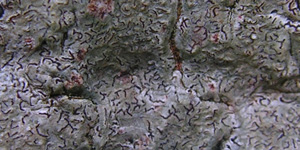Sticta ciliata
Spotting in the Field
The obvious key feature, the cilia on the margins of the young thalli, is a good conformation of identification, but is not actually the best way of spotting this species. The cilia are abundant on young thalli, but are tiny and absent on older thalli. In mature colonies, there may be few or no young thalli. The presence of apothecia strongly suggest this species, however, Sticta fuliginosa s. str. can very rarely also have apothecia, and these can also have similar ciliate margins. Also although fertile material can be expected in any large population it is always rare. In the field it is actually the general shape of the thalli that is the key feature.Young Thalli
The young thalli have plain margins, with very variable amounts of marginal cilia. These can be abundant but also can be sparse. Care is needed to distinguish between cilia and tomentum on the underside poking out from the underside; the cilia are simple and white, the tomentum furry and yellowish. When frequent to abundant the cilia are diagnostic, however, other species can rarely have cilia on damaged margins. The young thalli are also flat. Sticta fuliginoides young thalli are very different, rapidly developing into a trumpet shape.Mature Thalli
The mature thalli are medium sized, to a maximum of 3cm diameter, and have a distinctive rounded outline with shallowly crenulate margins. Closer up the neatly recurved margins are diagnostic. Sticta fuliginosa s. str. is a larger species, with mature thalli up to 10–12 cm across, with plain margins, a more irregular outline and more deeply divided. Sticta fuliginoides is also a smaller species and can have revolute margins in middle aged thalli, but has very different younger thalli.Summary
The main features are:- Medium sized mature thalli, rounded outline with recurved margins.
- Young thalli flat, usually with marginal cilia
- Confirmed microscopically by the numerous papillae on cyphella membrane cells (x400 & cross section, but the cyphella surfaces are visibly minutely bumpy at x40)
Sticta ciliata pictures



